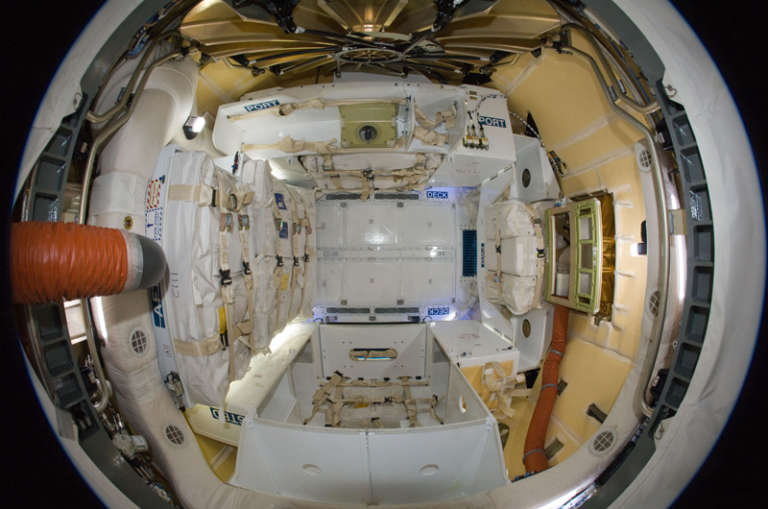Jason Davis • May 31, 2012
SpaceX's Dragon returns to Earth, completes mission
The first commercial spacecraft to visit the International Space Station has returned safely to Earth. At 11:42AM EDT (15:42 UTC), SpaceX’s Dragon capsule descended into a choppy Pacific Ocean approximately 900 kilometers southwest of Los Angeles, California. According to CEO Elon Musk, the vehicle’s landing accuracy was near-perfect. The success of the mission bolsters the burgeoning commercial spaceflight industry and positions SpaceX to begin paid cargo runs to the ISS later this year.

In this video from SpaceX, the Dragon capsule bobs in the Pacific, awaiting recovery:
After a nail-biting last-second abort during the first launch attempt May 19, the mission began on May 22 as the Falcon 9 rocket lit up the night sky over Cape Canaveral, ascending flawlessly into orbit. It became immediately clear that SpaceX’s launch coverage would differ drastically from NASA’s, as a throng of SpaceX employees outside the company’s Hawthorne headquarters erupted into cheers when the Dragon’s solar arrays unfolded. Later, they chanted “E-lon! E-lon!” as their CEO came out to greet them.
Despite the early wins, SpaceX and NASA acknowledged the most difficult part of the mission was yet to come. As the Dragon crept slowly towards the ISS for capture on May 25 -- flight day four -- it encountered its first real difficulty: inconsistent distance measurements coming from the vehicle’s LIDAR system. SpaceX flight controllers backed the vehicle away slowly to assess the situation, concluding the readings were caused by stray signal reflections coming from the station’s Japanese Experiment Module. The LIDAR’s field of view was narrowed, and the Dragon closed again to the designated ten-meter hold point.
NASA astronaut Don Pettit, with assistance from Joe Acaba and ESA crewmember André Kuipers, successfully grappled the Dragon with the station’s Canadarm2 at 9:56AM EDT (13:56 UTC). Pettit maneuvered the capsule over to the station’s Harmony module approximately two hours later, completing berthing at 12:02PM EDT (16:02 UTC).
The space station’s current commander, Russian cosmonaut Oleg Kononenko, joined Pettit and company on Saturday morning as the Dragon’s hatch was opened at 5:53AM EDT (9:53 UTC). Kononenko and Pettit entered the spacecraft wearing protective goggles and masks, quickly giving thumbs-ups to live NASA TV cameras as the air inside the capsule mixed with the station’s. The 520 kilograms of enclosed cargo in the vehicle was found to be safe and secure, and was unloaded during the following days.

After spending nearly a week connected to the station, the Dragon was released early Thursday May 31 at 5:49AM EDT (9:49 UTC). The spacecraft was packed with a half-ton of return cargo, demonstrating a capability that has gone unfulfilled since the 2011 retirement of America’s space shuttles.
At 10:51AM EDT (14:51 UTC), the Dragon’s Draco thrusters fired for nearly ten minutes, decelerating the craft enough for it to reenter Earth’s atmosphere. It jettisoned its unpressurized trunk, exposing the craft’s PICA-X (Phenolic Impregnated Carbon Ablator) heat shield. SpaceX's thermal protection system is a variant of NASA’s PICA heat shield, which was used on the Stardust Sample Return Capsule. A PICA shield will also be used to protect the Curiosity rover when it enters Mars’ atmosphere this August.
NASA was able to broadcast live, grainy video of the Dragon’s Pacific Ocean arrival from aircraft circling the recovery zone. Drogue chutes slowed and stabilized the plummeting capsule, followed by the deployment of three peppermint-striped main parachutes. Splashdown occurred at 11:42AM (15:42 UTC), and the Dragon was hauled onto a recovery barge a short time later.

The final mission elapsed time from liftoff to splashdown was 9 days, 7 hours, and 58 minutes.
The Time is Now.
As a Planetary Defender, you’re part of our mission to decrease the risk of Earth being hit by an asteroid or comet.
Donate Today

 Explore Worlds
Explore Worlds Find Life
Find Life Defend Earth
Defend Earth

